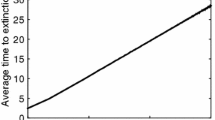Abstract
We propose the use of a stationary probability distribution for the analysis of data on population size. Predicting this long term population property from short term individual events is accomplished by the use of the asymptotic theory of stochastic processes. A WKB approximation to the stationary density is obtained and then applied to observations on the flour beetleTribolium.
Similar content being viewed by others
Literature
Bartlett, M. S. 1957. “On Theoretical Models for Competitive and Predatory Biological Systems”.Biometrika 44, 27–42.
— 1960.Stochastic Population Models New York: Wiley.
Bender, C. M. and S. A. Orszag. 1978.Advanced Mathematical Methods for Scientists and Engineers. New York: McGraw-Hill.
Cohen, J. K. and R. M. Lewis. 1967. “A Ray Method for the Asymptotic Solution of the Diffusion Equation.”J. Inst. Math. Applic. 3, 266–290.
Costantino, R. F. Costantino. 1988. “Analysis of Steady-State Populations with the Gamma Abundance Model and its Application toTribolium.”Ecology 69, 1200–1213.
— and G. P. Patil. 1984. “The Gamma Distribution and Weighted Multimodal Gamma Distributions as Models of Population Abundance.”Math. Biosci. 68, 187–212.
Desharnais, R. A. and R. F. Costantino. 1982. “The Approach to Equilibrium and the Steady-State Probability Distribution of Adult Numbers inTribolium brevicornis.”Am. Naturalist 119, 102–111.
— and—. 1985. “Genetic Analysis of a Population ofTribolium—VIII. The Stationary Stochastic Dynamics of Adult Numbers.”Can. J. Genet. Cytol. 27, 341–350.
— and L. Liu. 1987. “Stable Demographic Limit Cycles in Laboratory Populations ofTribolium castaneum.”J. Anim. Ecol. 56, 885–906.
Fujii, K. 1978. “Computer Simulation Study on the Cyclicities ofTribolium Population Dynamics.”Res. Population Ecol. 19, 155–169.
Gardiner, C. W. 1983Handbook of Stochastic Methods. Berlin: Springer.
Hastings, A. and R. F. Costantino. 1987. “Cannibalistic Egg-Larval Interactions inTribolium: An Explanation for the Oscillations in Population Numbers.”Am. Naturalist 130, 36–52.
Keller, J. B. 1978. “Rays, Waves and Asympotics.”Bull. Am. Math. Soc. 84, 727–750.
Knessl, C., M. Mangel, B. J. Matkowsky, Z. Schuss and C. Tier. 1984. “Solution of Kramers-Moyal Equations for Problems in Chemical Physics.”J. chem. Phys. 81, 1285–1293.
Landahl, H. D. 1955. “A Mathematical Model for the Temporal Pattern of a Population Structure with Particular Reference to the Flour Beetle.”Bull. math. Biophys. 17, 63–77.
Leslie, P. H. 1962. “A Stochastic Model for Two Competing Species ofTribolium and its Application to some Experimental Data.”Biometrika 49, 1–25.
—, T. Park and D. Mertz. 1968. “The Effect of Varying the Initial Numbers on the Outcome of Competition Between TwoTribolium Species.”J. Anim. Ecol. 37, 9–23.
Lloyd, M. 1965. “Laboratory Studies with Confined Cannibalistic Populations of Flour Beetle (Tribolium castaneum) in a Cold-Dry environment—I. Data for 24 Unmanipulated Populations.”Tribolium Infmn Bull. 8, 89–123.
— 1968. “Self-Regulation of Adult Members by Cannibalism in Two Laboratory Strains of Flour Beetles (Tribolium castaneum).”Ecology 49, 245–259.
Mangel, M. 1985. “Search Models in Fisheries and Agriculture.”Lect. Notes Biomath. 61, 105–138.
Neyman, J., T. Park and E. L. Scott. 1956. “Struggle for Existence, theTribolium model: Biological and Statistical Aspects.” InProceedings of the Third Berkeley Symposium on Mathematical Statistics and Probability, J. Neyman (Ed.), pp. 41–79. Berkeley, CA: University of California Press.
Park, T. 1954. “Experimental Studies of Interspecies Competition—II. Temperature, Humidity, and Competition in Two Species ofTribolium.”Phys. Zool. 27, 177–238.
—, P. H. Leslie and D. B. Mertz. 1964. “Genetic Strains and Competition in Populations ofTribolium.”Physiol. Zool. 37, 97–162.
Peters, C. S. 1987. Application of the WKB Method to Stochastic Problems in Operations Research and Biology. Ph.D. Dissertation Graduate Group in Applied Mathematics, University of California, Davis.
Roozen, H. 1987. “Equilibrium and Extinction in Stochastic Population Dynamics.”Bull. Math. Biol. 49, 671–696.
Stanley, J. 1932. “A Mathematical Theory of the Growth of Populations of the Flour Beetle,Tribolium confusum, Duval.”Can. J. Res. 6, 632–671.
Taylor, N. W. 1971. “Simulation ofTribolium Populations.”Ecol. Soc. Aust. 6, 105–115.
van Kampen, N. G. 1981.Stochastic Processes in Physics and Chemistry. Amsterdam: North Holland.
Author information
Authors and Affiliations
Rights and permissions
About this article
Cite this article
Peters, C.S., Mangel, M. & Costantino, R.F. Stationary distribution of population size inTribolium . Bltn Mathcal Biology 51, 625–638 (1989). https://doi.org/10.1007/BF02459970
Received:
Revised:
Issue Date:
DOI: https://doi.org/10.1007/BF02459970




